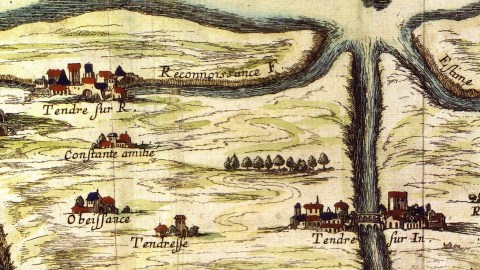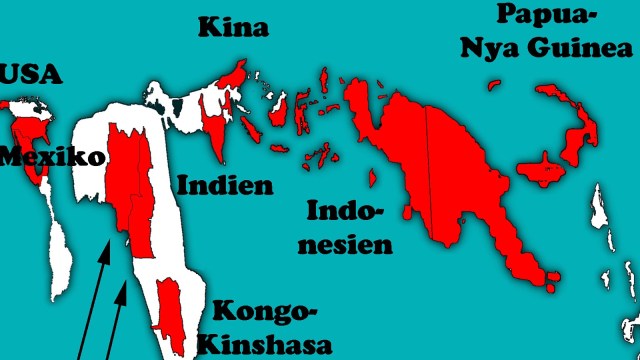La Carte de Tendre: Two Topographies of Love

One of the earliest, and most influential examples of sentimental cartography is the Carte de Tendre, an example of the highly refined imagination prevalent in 17th century French literary salons. (Another one is Strange Maps #59, a German map of the Empire of Love)
The fictional country of Tendre (‘Tender’) was inspired by Clélie, Histoire romaine, a novel by Madeleine de Scudéry (1607-1701), whose much-frequented and tone-setting salon was one of the focal points of Préciosité, a rarefied literary genre noted for its effusive erudition and gallantry.
The map of Tendre is a topographic allegory, representing the stations of love as if they were real paths and places. The country is bisected by the Inclination (‘Disposition’), a river that runs south to north, joined by two smaller rivers, the Estime (‘Respect’) and the Reconnaissance (‘Gratitude’), before plunging into La mer dangereuse (‘the Dangerous Sea’), which is separated from a reef-ridden narrows from Terres inconnues (‘Unknown Lands’). To the west are the decidedly choppy waters of the Mer d’Inimitié (‘Sea of Enmity’).

The smooth flow of the rivers symbolises the control over passions, the perils of the sea the danger of unbridled emotions. Straddling the rivers are three eponymous capital cities: Tendre-sur-Estime, Tendre-sur-Reconnaissance and Tendre-sur-Inclination. Places along those rivers mark the waypoints of ‘civilised’ love and some of its pitfalls:
Marking the road from Nouvelle amitié (‘New Friendship’) to Tendre-sur-Reconnaissance are the following towns, purportedly representing a gradual increase of affection:
- Complaisance (‘Kindness’ or ‘Smugness’)
- Soumission (‘Submission’)
- Petits soins (‘Care of Small Things’)
- Assiduité (‘Attentiveness’)
- Empressement (‘Eagerness’)
- Grands services (‘Great Favours’)
- Sensibilité (‘Sensibility’)
- Tendresse (‘Tenderness’)
- Obéissance (‘Obedience’)
- Constante amitié (‘Constant Friendship’)
However, close to the forbidding rock fortress of Orgueil (‘pride’) in the extreme south-west are places to be avoided, such as:
- Meschanceté (‘meanness’)
- Medisance (‘disparagement’)
- Perfidie (‘betrayal’)
- Indiscretion (‘indiscretion’)
Equally avoidable are the localities leading from Nouvelle amitié towards the Lac d’Indifference (‘Lake Disinterest’):
- Négligence (‘Negligence’)
- Inesgalité (‘Inequality’)
- Tiédeur (‘Lukewarmnessâ)
- Légèreté (‘Levity’)
- Oubli (‘Oblivion’)
Leading towards Tendre-sur-Inclination and beyond to Tendre-sur-Estime are the towns of:
- Grand-esprit (‘Great Wit’)
- Iolis Vers (‘Beautiful Verse’)
- Billet galant (‘Gallant Letter’)
- Billet doux (‘Sentimental Letter’)
- Sincérité (‘Sincerity’)
- Grand Coeur (‘Magnanimity’)
- Probité (‘Probity’)
- Générosité (‘Generosity’)
- Exactitude (‘Punctuality’)
- Respect (‘Respect’)
- Bonté (‘Goodness’)
The Carte de Tendre is more than just allegorical. The territory is shaped to resemble certain parts of the female anatomy – a literal as well as a literary topography of love. That risqué in-joke, in contrast with the pious surface meaning of the map, must have greatly amused those 17th-century salonists.
This map was found on this page of the University of Richmond (Virginia, US).
Strange Maps #245
Got a strange map? Let me know at strangemaps@gmail.com.





